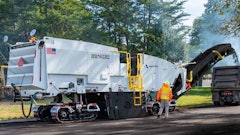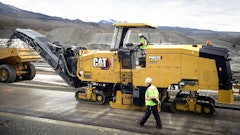
Contract disincentive clauses are as common as the tight schedules and security challenges associated with airport construction problems. However, when a contractor faces a $500,000-per-day disincentive for not completing the project on time, this is high stakes work. Even the smallest scheduling delay, especially early in the project, results in a domino effect of postponements, which puts meeting the deadline in jeopardy.
This is precisely what Las Vegas Paving, Las Vegas, NV, faces with its current airport runway and taxiway reconstruction project at McCarran International Airport. On Nov. 1, 2008, the area's largest heavy civil engineering contractor started a massive six-month, $75 million milling and paving project on the airport's busiest runway, 25L/7R.
The project consisted of asphalt removal of the entire 10,525-foot length of the runway and an 11,000-foot-long taxiway. The base was then brought to grade with a P-209 aggregate and a concrete runway and taxiway was paved, while a P-401 spec asphalt pavement lined the shoulders. If Las Vegas Paving does not complete the project by May 1, 2009, it loses a half-million dollars for every day the project stretches beyond the deadline.
Failure not an option
Since Las Vegas Paving originally paved the runway and taxiway, the contractor had in-depth knowledge of what it faced when removing the pavement. "We paved the asphalt runway 18 years ago, and it was still in good shape," says Ryan Mendenhall, project manager and estimator for Las Vegas Paving. "This asphalt is a little stiffer and more abrasive than the typical mix for a roadway project."
In order to keep the six-month project on schedule, Las Vegas Paving had to quickly remove the asphalt runway and taxiway in order to begin grade work and paving.
Less than three weeks were scheduled for removal of more than four linear miles of asphalt. Considering the 100- and 150-foot widths for the taxiway and runway respectively, the task was equivalent to removing more than 42 lane miles of roadway. With pavement thicknesses ranging from 9 to 11 inches for the taxiway and 11 to 13 inches for the runway, Las Vegas Paving removed more than 300,000 tons of asphalt.
Undaunted by the challenge, the contractor put three cold planers to work — two Terex PR800 7-12s and a new three-track Terex PR950, purchased specifically for this job. The grueling schedule required Las Vegas Paving's crews to work 24 hours per day, 7 days a week for the first month, and the mills ran 20 to 22 hours per day, stopping only for fuel and daily maintenance between the two 12-hour crew shifts. "We put approximately 340 hours on each machine in a very short period of time," Mendenhall says.
Flawless beginning
While Las Vegas Paving was not allowed to close runway 25L/7R until Nov. 1, the contractor was able to perform some work in preparation of the closing. In October, crews completed some electrical work and dug postholes for the security fence that would ultimately surround the construction site.
As soon as Las Vegas Paving was allowed to close the runway, the company put up 15,000 linear feet of fence.
"Security was very tight for the first seven days while we erected the fence," Mendenhall comments. "Once we secured the site with the fence, then it was considered a land site and security was up to us. This had to be done in order to keep up with production."
On Nov. 3, Las Vegas Paving started milling. Each cold planer cut an 11-foot 3-inch width per pass. It required 13 side-by-side passes to complete removal of the runway and nine side-by-side passes for the taxiway. Clean-up milling was tackled by the Terex PR165 utility mill.
The company's new PR950 was the workhorse on the project. At 950 hp, it features 150 hp more power than Las Vegas Paving's older PR800 7-12 Roto-Mills, and the difference was noticeable. "The PR950 is just an animal. You can mill as fast and as deep as you want," Mendenhall says. "It delivered more production than we expected."
Enhancing productivity, the vertically integrated Las Vegas Paving owns a fleet of trucks, so it was able to dedicate 20 sets of doubles - capable of holding up to 38 tons of millings per set - to the job. The crew kept a trailer underneath the mill's 42-inch-wide upper discharge conveyor belt. "The PR950 loaded a set of doubles in about four minutes," Mendenhall explains.
The contractor experimented with milling depths. With a 48-inch-diameter rotor, the PR950 delivers up to 15-inch deep cuts. In some areas, workers milled full depth, up to 13 inches, while other depths were set at 6 inches.
"We tested to see what depths optimized production," Mendenhall mentions. All areas of the runway and taxiway were milled to grade in either one or two passes.
"No matter whether milling at 6 or 13 inches, the PR950 milled up a very consistent material," he adds.
Las Vegas Paving found that while it was more impressive to see the cold planer mill full depth in one pass, maximum productivity was achieved at 6-inch depths in most areas of the runway and taxiway.
"It's common to achieve higher productivity numbers at shallower milling depths," comments Tom Brooks, cold planer project manager for Terex Roadbuilding. "Although the machine cuts more material at full depth, the mill's faster operating speed at shallower depths more than makes up for this loss."
In just 16 short days, the PR950 and PR800 7-12s delivered the production and durability required to complete the 300,000 ton job. Paving subcontractor ACME Concrete Paving made its first pour on November 19, as scheduled.
Las Vegas Paving left approximately 25 percent of the millings on site to be used at the Clark County Department of Aviation's discretion. According to Mendenhall, some of the recycled asphalt will be used on the $1.4-billion expansion project of McCarran International Airport Terminal 3, and the Department of Aviation blends the millings with natural material to use for embankments and to cover the infield.
The remaining 225,000 tons of millings were trucked to Las Vegas Paving's Blue Diamond asphalt plant, where they will be used as RAP (reclaimed asphalt pavement) in a number of mix designs for upcoming projects.
"We can incorporate up to 15 percent RAP in our asphalt for projects in the City of Las Vegas, Clark County and a number of surrounding communities," Mendenhall explains. With liquid asphalt prices still riding high in the $400-per-ton range, this will result in significant savings for the contractor.
Purchasing the new PR950 specifically for the McCarran International Airport project was a wise investment for Las Vegas Paving, as it paid off in a number of ways for the contractor. "We were very happy with the machine's performance," Mendenhall says. In addition to dependably tackling the grueling 22-hour schedule that the contract required, most importantly it kept this portion of the project on schedule.
Las Vegas Paving turns 50
The year was 1958. Chevy's now classic car just turned one year old. President Dwight D. Eisenhower signed the Alaska Statehood Act into United States law. And one Las Vegas entrepreneur, Robert L. Mendenhall, took a gamble and started a new asphalt paving company, Las Vegas Paving. With little capital but a large amount of determination, Mendenhall grew the company from a single paver operation to one of the top 100 companies in the nation in terms of fleet size. Today, the vertically integrated heavy civil contractor boasts multiple divisions ranging from excavation and grading to hot mix asphalt production to trucking to, of course, asphalt paving. The company employs over 1,000 people and has an annual contract volume of approximately $400 million. At the core of Las Vegas Paving's success has always been asphalt paving and production. A single asphalt plant purchased in 1960 has grown to seven throughout the Las Vegas metro area. The company has produced more than 30 million tons of asphalt over the years and has been at the forefront of asphalt recycling since 1972. The journey of more than 40,000 miles of asphalt paved by Las Vegas Paving began with a single Cedarapids (now Terex) BSF paver. As a sign of respect and admiration, the employees of Las Vegas Paving wanted to give Mendenhall a special gift for the company’s golden anniversary. Approximately two years ago, Las Vegas Paving employees began working with Terex Roadbuilding and their Terex dealer, Herrmann Equipment, to find the BSF paver that started it all. After an extensive search, they were able to locate the paver, and Las Vegas Paving purchased and restored it to original condition. The employees gave Mendenhall the paver at the company’s 50th Anniversary celebration. The Cedarapids BSF steel track paver now sits as a landmark outside the company’s dispatch facility.
















![Screen Shot 2023 01 04 At 5 23 30 Pm[35]](https://img.forconstructionpros.com/files/base/acbm/fcp/image/2023/01/Screen_Shot_2023_01_04_at_5.23.30_PM_35_.63bc42696de27.png?auto=format%2Ccompress&fit=crop&h=135&q=70&w=240)


![Bm 2200 65 Cold Planer Release[17]](https://img.forconstructionpros.com/files/base/acbm/fcp/image/2023/06/BM_2200_65_Cold_Planer_release_17_.649359d81b660.png?auto=format%2Ccompress&fit=crop&h=135&q=70&w=240)




